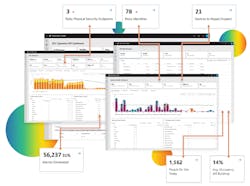Vector Flow bridges the gap in security data integration
In the migration from analog to IP, one of the benefits that has long been touted by security vendors is the ability to bring data that is being generated by a multitude of sensors and integrate it into a common operating picture for end-users. But for all the research and development that has gone into tying these systems together, many organizations have reverted to using these systems – video surveillance, access control, intrusion detection, etc. – in their respective silos without spending much effort or budget to see how they could glean greater intelligence from them.
One company that is looking to change that is Vector Flow, which made its official debut to the physical and cyber-physical security market last week with the launch of its physical security automation platform. The Vector Flow platform leverages AI algorithms to aggregate data and automate security functions related to physical identity and access operations, security operation center (SOC) automation, and cyber-physical defense.
“These solutions and IoT devices are spitting out a large volume of data in the form of logs, journals, video, spatial data, and other data streams associated with these devices. This data is not analyzed and largely thrown away today, however; this data has lots of intelligence in it and this is our market opportunity,” Vector Flow President and CEO Ajay Jain told members of the media during a virtual press conference announcing the company’s launch. “Leveraging the power of such available data and drawing AI-based intelligence from it, Vector Flow streamlines the physical security industry and automates lots of tasks in the workflows that are done manually today.”
There are three categories of solutions that run on the new Vector Flow platform, including:
- Physical workforce identity access management, which streamlines the identity on/off boarding processes, physical access provisioning, access audits, compliance to regulations and risks analysis. Applications include:
o Unification of identities, access and badges
o Intelligent access provisioning: Enforcing right ID and right access
o Perpetual audit and remediation for 24/7 compliance
o Mobile self-service for employees and partners
o Real-time identity risks and prescriptions
o Real-time building occupancy management and prediction
o Adaptive policies for emergency/pandemic access management
- Physical SOC automation which uses AI-based automation for SOC operations and autonomous alarm reduction and reporting, along with multiple functions to optimize overall operations. Applications include:
o False alarm reduction
o Unlimited device monitoring and automated optimization
o Auto detection of faulty devices
o Configuration automation
o Intelligent SOC virtual assistants using machine learning playbooks
- Cyber-physical security which performs an audit of physical security as it relates to cyber defense. For example, it enforces “defense in depth” concepts using advanced AI models to detect vulnerabilities related to critical infrastructure, like the data centers or laboratory doors. It also manages the vulnerabilities of the IoT devices in the physical security and building automation world to prevent cyber surface attacks. Vector Flow’s technology not only will help in automating critical functions of physical security but also provide defense against cyber-physical attacks with an extra layer of security. This category of applications will be available in 2022. Applications include:
o Cyber-physical security defense
o Insider threats/breach detection
o Auto detection of IoT device vulnerabilities
“We’re taking a holistic approach to solve problems in this industry and our focus is very customer-centric,” Jain adds. “At the base level we have physical security department-level applications that use data intelligence and streamline security processes. For example, physical security is laden with nuisance alarms; we all know that and any company you walk in you will see tons of false nuisance alarms scrolling at the alarm console, but many companies mask their alarms by having them not show up in the console but that’s not a solution, it’s a bad band-aid, it’s a security hole. Our machine learning models analyze the data and find the root cause automatically. The models are run 24/7 and our software robots continuously monitor and optimize each and every IoT device so that it would not alarm unnecessarily.
“At the enterprise level, we have applications dedicated to physical identity and access management, audit compliance and privacy,” Jain continues. “Vector Flow analyzes risks emanating from identities or access areas, for example, determines and remediates the gaping holes using specialized machine learning models and sophisticated rules engine to protect customers’ critical assets – people and things. Think of it as an intelligent army of software robots relentlessly obsessed with finding security holes and remediating it.”
Incorporating cyber-physical defense into the platform to help organizations protect against increased threats from hackers and malicious insiders is one of the company’s key differentiators, according to Jain.
“There are a lot of companies doing cybersecurity stuff, but we are the only company, which I believe, is addressing the cyber-physical security side of the house,” he says. “At the cybersecurity level, we are designing solutions to protect against cyber-attacks emanating purely from physical security infrastructure, IoT devices and applications.”
Vector Flow is currently in the process of onboarding several large enterprise customers and recently received over $9 million in Series A funding from several venture capital funds led by Mayfield Fund with participation from Foundation Capital.
About the Author
Staff Reports
Editorial and news reports authored by the media team from Cygnus Security Media, including SecurityInfoWatch.com, Security Technology Executive magazine and Security Dealer & Integrator (SD&I) magazine.
